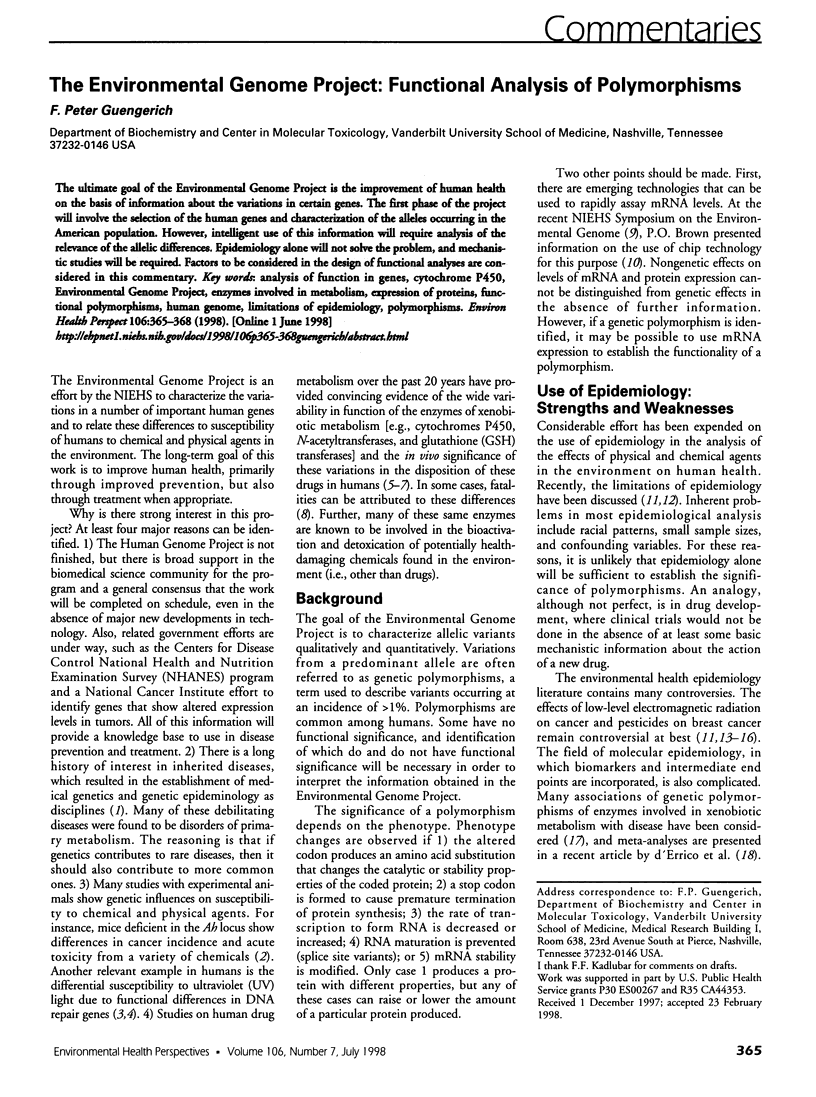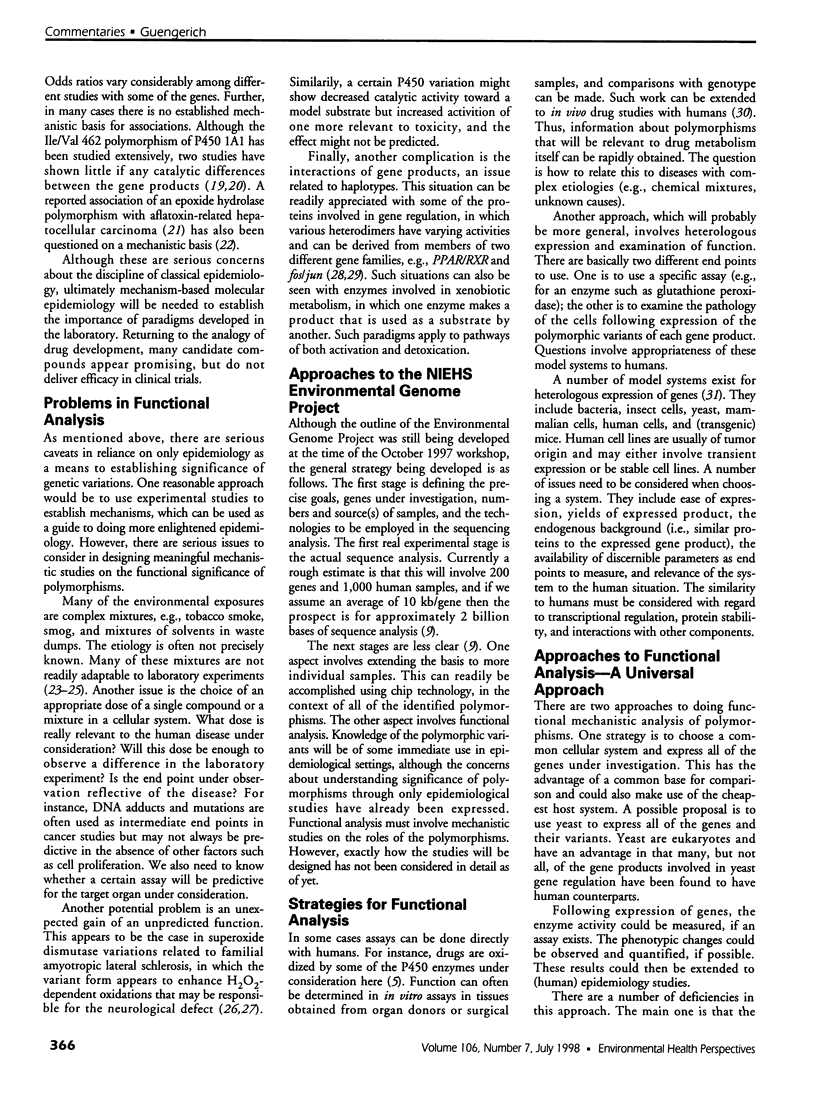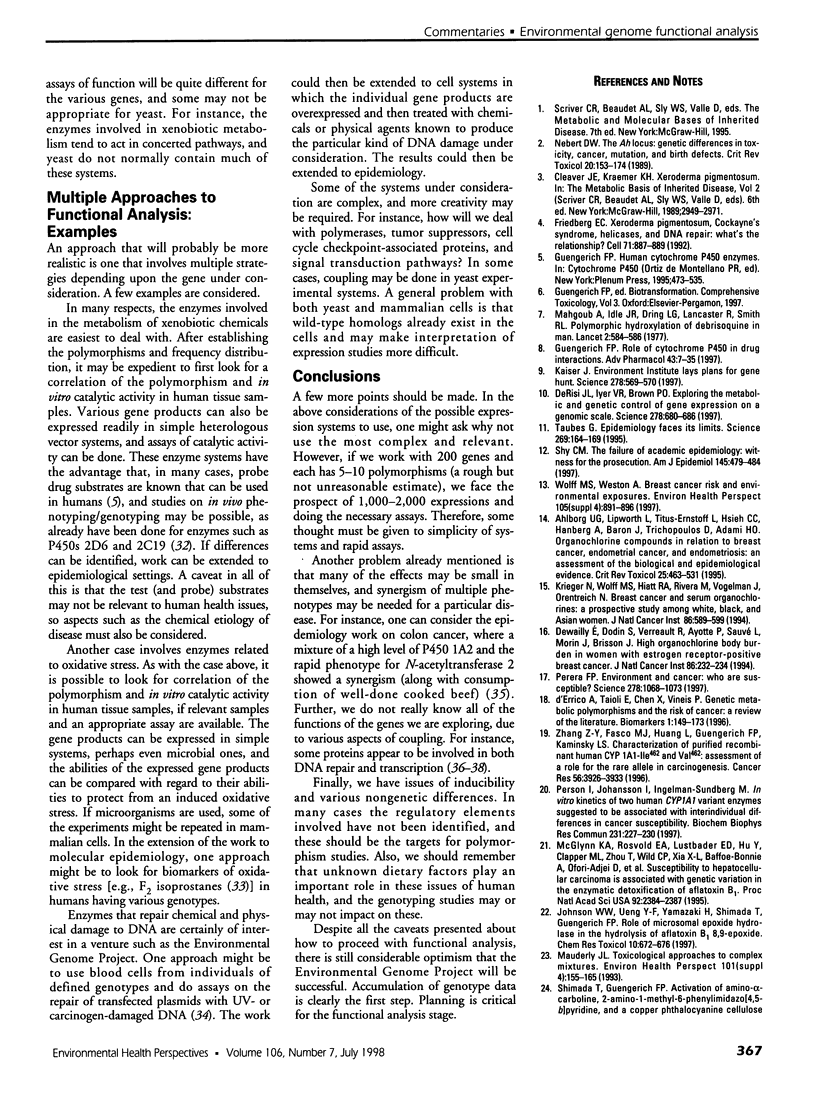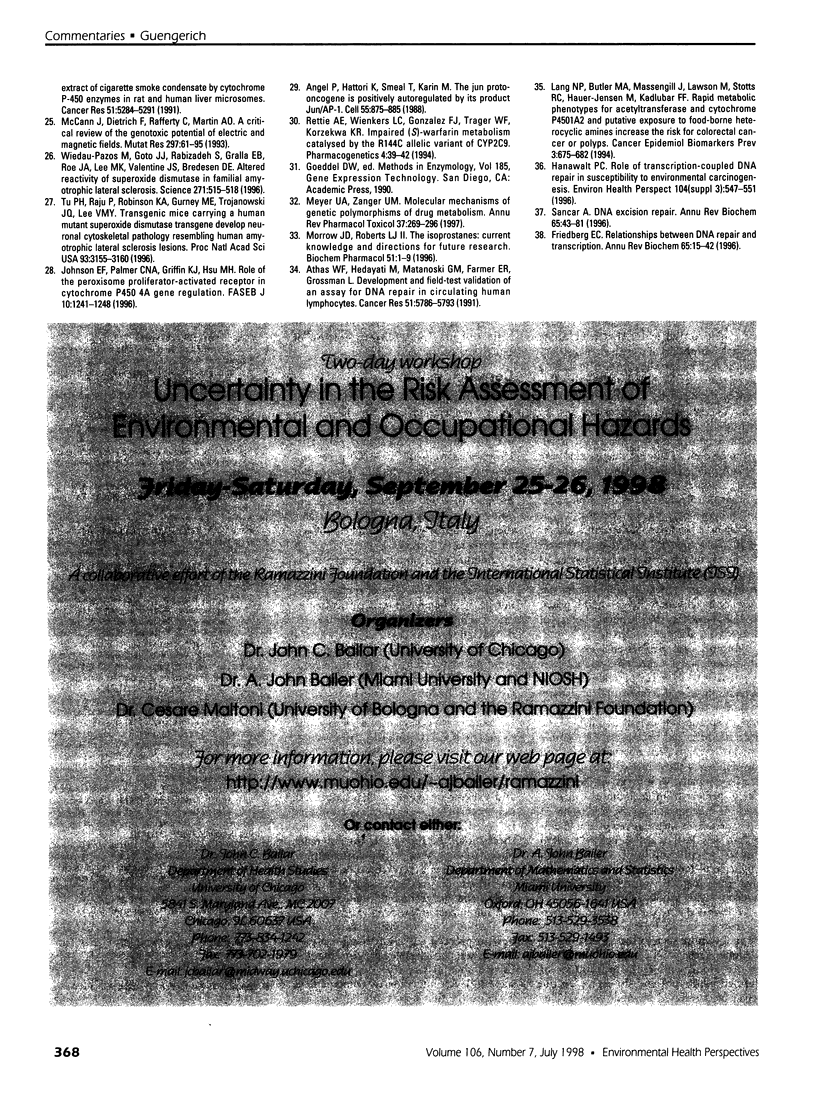Abstract
The ultimate goal of the Environmental Genome Project is the improvement of human health on the basis of information about the variations in certain genes. The first phase of the project will involve the selection of the human genes and characterization of the alleles occurring in the American population. However, intelligent use of this information will require analysis of the relevance of the allelic differences. Epidemiology alone will not solve the problem, and mechanistic studies will be required. Factors to be considered in the design of functional analyses are considered in this commentary.
Full text
PDF



Selected References
These references are in PubMed. This may not be the complete list of references from this article.
- Ahlborg U. G., Lipworth L., Titus-Ernstoff L., Hsieh C. C., Hanberg A., Baron J., Trichopoulos D., Adami H. O. Organochlorine compounds in relation to breast cancer, endometrial cancer, and endometriosis: an assessment of the biological and epidemiological evidence. Crit Rev Toxicol. 1995;25(6):463–531. doi: 10.3109/10408449509017924. [DOI] [PubMed] [Google Scholar]
- Angel P., Hattori K., Smeal T., Karin M. The jun proto-oncogene is positively autoregulated by its product, Jun/AP-1. Cell. 1988 Dec 2;55(5):875–885. doi: 10.1016/0092-8674(88)90143-2. [DOI] [PubMed] [Google Scholar]
- Athas W. F., Hedayati M. A., Matanoski G. M., Farmer E. R., Grossman L. Development and field-test validation of an assay for DNA repair in circulating human lymphocytes. Cancer Res. 1991 Nov 1;51(21):5786–5793. [PubMed] [Google Scholar]
- Dewailly E., Dodin S., Verreault R., Ayotte P., Sauvé L., Morin J., Brisson J. High organochlorine body burden in women with estrogen receptor-positive breast cancer. J Natl Cancer Inst. 1994 Feb 2;86(3):232–234. doi: 10.1093/jnci/86.3.232. [DOI] [PubMed] [Google Scholar]
- Friedberg E. C. Relationships between DNA repair and transcription. Annu Rev Biochem. 1996;65:15–42. doi: 10.1146/annurev.bi.65.070196.000311. [DOI] [PubMed] [Google Scholar]
- Friedberg E. C. Xeroderma pigmentosum, Cockayne's syndrome, helicases, and DNA repair: what's the relationship? Cell. 1992 Dec 11;71(6):887–889. doi: 10.1016/0092-8674(92)90384-o. [DOI] [PubMed] [Google Scholar]
- Guengerich F. P. Role of cytochrome P450 enzymes in drug-drug interactions. Adv Pharmacol. 1997;43:7–35. doi: 10.1016/s1054-3589(08)60200-8. [DOI] [PubMed] [Google Scholar]
- Hanawalt P. C. Role of transcription-coupled DNA repair in susceptibility to environmental carcinogenesis. Environ Health Perspect. 1996 May;104 (Suppl 3):547–551. doi: 10.1289/ehp.96104s3547. [DOI] [PMC free article] [PubMed] [Google Scholar]
- Johnson E. F., Palmer C. N., Griffin K. J., Hsu M. H. Role of the peroxisome proliferator-activated receptor in cytochrome P450 4A gene regulation. FASEB J. 1996 Sep;10(11):1241–1248. doi: 10.1096/fasebj.10.11.8836037. [DOI] [PubMed] [Google Scholar]
- Johnson W. W., Yamazaki H., Shimada T., Ueng Y. F., Guengerich F. P. Aflatoxin B1 8,9-epoxide hydrolysis in the presence of rat and human epoxide hydrolase. Chem Res Toxicol. 1997 Jun;10(6):672–676. doi: 10.1021/tx960209j. [DOI] [PubMed] [Google Scholar]
- Kaiser J. Environment institute lays plans for gene hunt. Science. 1997 Oct 24;278(5338):569–570. doi: 10.1126/science.278.5338.569. [DOI] [PubMed] [Google Scholar]
- Krieger N., Wolff M. S., Hiatt R. A., Rivera M., Vogelman J., Orentreich N. Breast cancer and serum organochlorines: a prospective study among white, black, and Asian women. J Natl Cancer Inst. 1994 Apr 20;86(8):589–599. doi: 10.1093/jnci/86.8.589. [DOI] [PubMed] [Google Scholar]
- Lang N. P., Butler M. A., Massengill J., Lawson M., Stotts R. C., Hauer-Jensen M., Kadlubar F. F. Rapid metabolic phenotypes for acetyltransferase and cytochrome P4501A2 and putative exposure to food-borne heterocyclic amines increase the risk for colorectal cancer or polyps. Cancer Epidemiol Biomarkers Prev. 1994 Dec;3(8):675–682. [PubMed] [Google Scholar]
- Mahgoub A., Idle J. R., Dring L. G., Lancaster R., Smith R. L. Polymorphic hydroxylation of Debrisoquine in man. Lancet. 1977 Sep 17;2(8038):584–586. doi: 10.1016/s0140-6736(77)91430-1. [DOI] [PubMed] [Google Scholar]
- Mauderly J. L. Toxicological approaches to complex mixtures. Environ Health Perspect. 1993 Dec;101 (Suppl 4):155–165. doi: 10.1289/ehp.93101s4155. [DOI] [PMC free article] [PubMed] [Google Scholar]
- McCann J., Dietrich F., Rafferty C., Martin A. O. A critical review of the genotoxic potential of electric and magnetic fields. Mutat Res. 1993 Jul;297(1):61–95. doi: 10.1016/0165-1110(93)90008-b. [DOI] [PubMed] [Google Scholar]
- McGlynn K. A., Rosvold E. A., Lustbader E. D., Hu Y., Clapper M. L., Zhou T., Wild C. P., Xia X. L., Baffoe-Bonnie A., Ofori-Adjei D. Susceptibility to hepatocellular carcinoma is associated with genetic variation in the enzymatic detoxification of aflatoxin B1. Proc Natl Acad Sci U S A. 1995 Mar 14;92(6):2384–2387. doi: 10.1073/pnas.92.6.2384. [DOI] [PMC free article] [PubMed] [Google Scholar]
- Meyer U. A., Zanger U. M. Molecular mechanisms of genetic polymorphisms of drug metabolism. Annu Rev Pharmacol Toxicol. 1997;37:269–296. doi: 10.1146/annurev.pharmtox.37.1.269. [DOI] [PubMed] [Google Scholar]
- Morrow J. D., Roberts L. J., 2nd The isoprostanes. Current knowledge and directions for future research. Biochem Pharmacol. 1996 Jan 12;51(1):1–9. doi: 10.1016/0006-2952(95)02072-1. [DOI] [PubMed] [Google Scholar]
- Nebert D. W. The Ah locus: genetic differences in toxicity, cancer, mutation, and birth defects. Crit Rev Toxicol. 1989;20(3):153–174. doi: 10.3109/10408448909017908. [DOI] [PubMed] [Google Scholar]
- Perera F. P. Environment and cancer: who are susceptible? Science. 1997 Nov 7;278(5340):1068–1073. doi: 10.1126/science.278.5340.1068. [DOI] [PubMed] [Google Scholar]
- Persson I., Johansson I., Ingelman-Sundberg M. In vitro kinetics of two human CYP1A1 variant enzymes suggested to be associated with interindividual differences in cancer susceptibility. Biochem Biophys Res Commun. 1997 Feb 3;231(1):227–230. doi: 10.1006/bbrc.1997.6051. [DOI] [PubMed] [Google Scholar]
- Rettie A. E., Wienkers L. C., Gonzalez F. J., Trager W. F., Korzekwa K. R. Impaired (S)-warfarin metabolism catalysed by the R144C allelic variant of CYP2C9. Pharmacogenetics. 1994 Feb;4(1):39–42. doi: 10.1097/00008571-199402000-00005. [DOI] [PubMed] [Google Scholar]
- Sancar A. DNA excision repair. Annu Rev Biochem. 1996;65:43–81. doi: 10.1146/annurev.bi.65.070196.000355. [DOI] [PubMed] [Google Scholar]
- Shy C. M. The failure of academic epidemiology: witness for the prosecution. Am J Epidemiol. 1997 Mar 15;145(6):479–487. doi: 10.1093/oxfordjournals.aje.a009133. [DOI] [PubMed] [Google Scholar]
- Taubes G. Epidemiology faces its limits. Science. 1995 Jul 14;269(5221):164–169. doi: 10.1126/science.7618077. [DOI] [PubMed] [Google Scholar]
- Tu P. H., Raju P., Robinson K. A., Gurney M. E., Trojanowski J. Q., Lee V. M. Transgenic mice carrying a human mutant superoxide dismutase transgene develop neuronal cytoskeletal pathology resembling human amyotrophic lateral sclerosis lesions. Proc Natl Acad Sci U S A. 1996 Apr 2;93(7):3155–3160. doi: 10.1073/pnas.93.7.3155. [DOI] [PMC free article] [PubMed] [Google Scholar]
- Wiedau-Pazos M., Goto J. J., Rabizadeh S., Gralla E. B., Roe J. A., Lee M. K., Valentine J. S., Bredesen D. E. Altered reactivity of superoxide dismutase in familial amyotrophic lateral sclerosis. Science. 1996 Jan 26;271(5248):515–518. doi: 10.1126/science.271.5248.515. [DOI] [PubMed] [Google Scholar]
- Wolff M. S., Weston A. Breast cancer risk and environmental exposures. Environ Health Perspect. 1997 Jun;105 (Suppl 4):891–896. doi: 10.1289/ehp.97105s4891. [DOI] [PMC free article] [PubMed] [Google Scholar]
- Zhang Z. Y., Fasco M. J., Huang L., Guengerich F. P., Kaminsky L. S. Characterization of purified human recombinant cytochrome P4501A1-Ile462 and -Val462: assessment of a role for the rare allele in carcinogenesis. Cancer Res. 1996 Sep 1;56(17):3926–3933. [PubMed] [Google Scholar]


